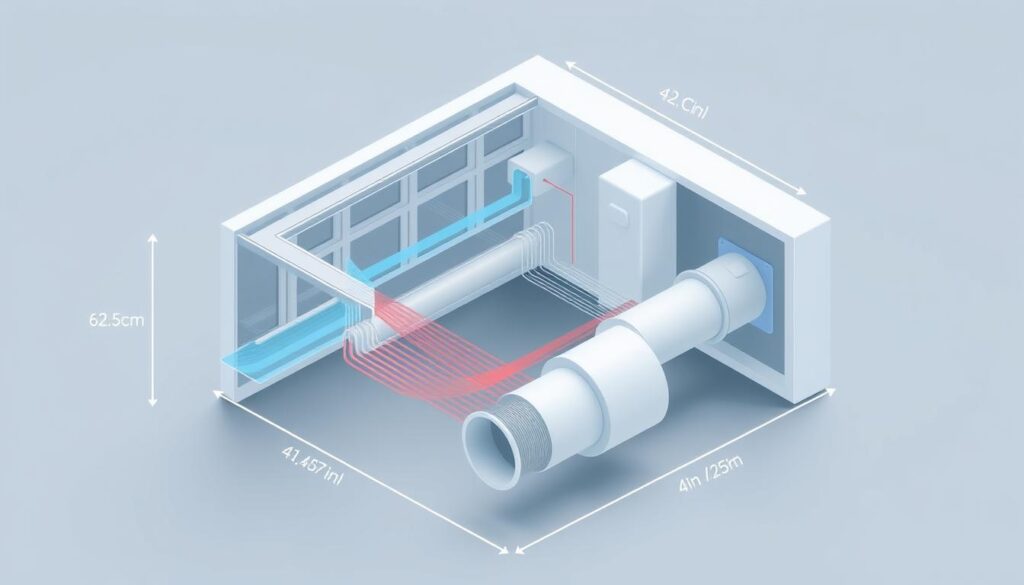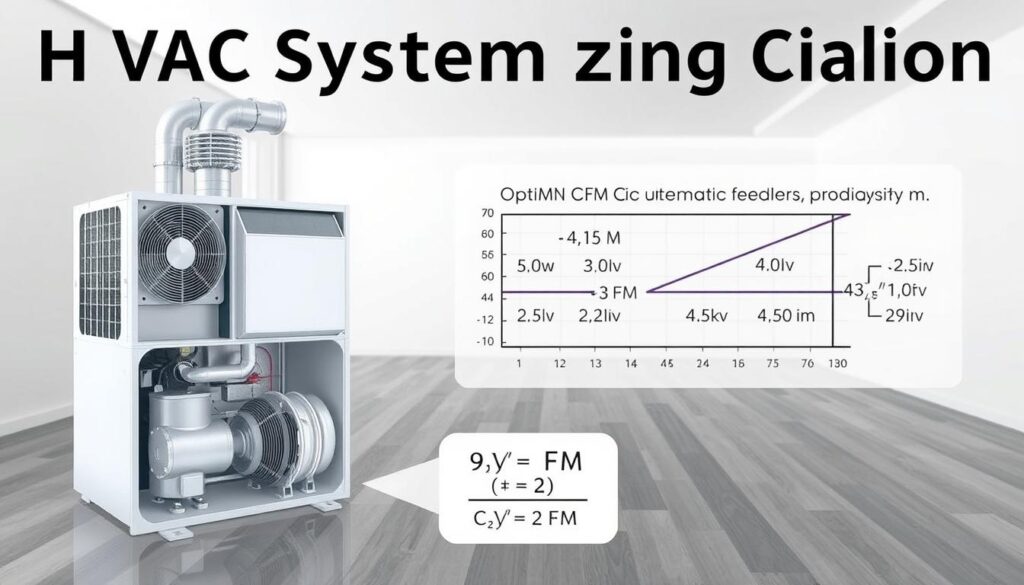Affiliate Disclosure
HVAC Guide Guys is a participant in the Amazon Services LLC Associates Program, an affiliate advertising program designed to provide a means for sites to earn advertising fees by advertising and linking to Amazon.
How Much CFM Do I Need HVAC? Are you having trouble figuring out the right airflow for your home? Knowing how much CFM you need for your HVAC system is key. It helps create the perfect indoor environment.

CFM, or Cubic Feet per Minute, is a critical measurement. It shows how much air your system moves through your home. This affects your comfort, energy use, and air quality.
Getting your HVAC system airflow right isn’t just about numbers. It’s about making your home comfortable all year round. You want it cool in summer and warm in winter, with good air flow.
Key Takeaways
- CFM measures the volume of air moving through your HVAC system
- Proper airflow is key for comfort and energy savings
- Different rooms need different CFM levels
- Wrong CFM can cause uneven temperatures
- Getting a pro to assess your needs is best
Table of Contents
Understanding CFM in HVAC Systems
Keeping your home comfortable means knowing about airflow. Cubic Feet per Minute (CFM) is a key measure. It shows how well your HVAC system works.
CFM shows the air volume your system moves in one minute. It’s vital for good indoor air and system efficiency.
What is Cubic Feet per Minute (CFM)?
CFM measures air flow through your home’s system. It’s like your HVAC’s breathing capacity. Each space needs a specific CFM for comfort and air quality.
- Measures air volume movement
- Critical for HVAC system performance
- Varies based on room size and purpose
Why CFM Matters for Your Home
HVAC rates affect your comfort and energy use. The wrong CFM can cause:
- Poor air circulation
- Inconsistent room temperatures
- Higher energy consumption
- Reduced system lifespan
The Role of CFM in Ventilation
Good ventilation does more than control temperature. It removes pollutants, manages humidity, and brings in fresh air. Accurate CFM calculations are key to a healthier home.
Knowing your home’s CFM needs can save money and improve air quality.
Explore Our HVAC Shop
Looking for top-rated HVAC tools, parts, and accessories? Visit our shop and find the perfect solution for your needs.
Visit the ShopHow Much CFM Do I Need HVAC: Essential Calculations
Getting to know how much CFM your home needs starts with learning the basics. HVAC pros use special methods to figure this out. The cubic feet per minute (CFM) is key for the right airflow in your home.
Calculating HVAC load involves several important steps. These steps help find out how much airflow your home needs. HVAC experts use a detailed formula to find CFM:
- Measure the room’s square footage
- Consider ceiling height
- Determine air changes per hour (ACH)
- Apply the standard CFM calculation formula
The formula for CFM is: CFM = Room Area (sq. ft.) x Ceiling Height (ft.) x ACH / 60. This formula shows exactly how much airflow each room in your home needs.
Several things affect how much CFM your home needs:
- Room dimensions
- Ceiling height
- Number of windows
- Insulation quality
- Local climate conditions
You can try these calculations yourself. But, talking to a professional HVAC tech is best. They can give a detailed look at your home’s airflow needs. They consider your home’s special features and the local weather.
“Proper CFM calculation is the foundation of an efficient HVAC system” – HVAC Industry Standard
Explore Our HVAC Shop
Looking for top-rated HVAC tools, parts, and accessories? Visit our shop and find the perfect solution for your needs.
Visit the ShopThe Relationship Between Room Size and CFM Requirements
It’s important to know how room size affects airflow for good indoor air quality. Your HVAC system needs the right CFM for room size. This means doing some careful math and thinking.
Room volume is key to finding the right airflow. The CFM needed changes based on several important factors:
- Room dimensions
- Ceiling height
- Room function
- Number of occupants
Room Volume Calculations
To figure out your room’s airflow needs, multiply its length, width, and height. This tells you the total cubic feet. For hvac duct sizing, experts suggest 1 CFM per square foot of room space.
Standard CFM Requirements by Room Type
Different rooms need different ventilation levels. Here’s a quick guide:
- Bedrooms: 50-80 CFM
- Living Rooms: 75-100 CFM
- Kitchens: 100-150 CFM
- Bathrooms: 50-70 CFM
Impact of Ceiling Height on CFM
Standard ceiling heights (8-9 feet) usually match typical CFM calculations. But rooms with higher ceilings need more airflow. For every foot above standard, you might need 10-15% more CFM.
Pro tip: Always consult an HVAC professional for precise measurements specific to your home’s unique characteristics.
Air Changes Per Hour (ACH) and Its Impact on CFM
Knowing about hvac ventilation rates is key for good indoor air. Air Changes Per Hour (ACH) is important for figuring out CFM for hvac systems. It shows how many times the air in your space is replaced in one hour.

The ACH standards change based on the room’s use and how many people are there. Here are some common ACH guidelines:
- Living rooms: 3-4 air changes per hour
- Bedrooms: 2-3 air changes per hour
- Kitchens: 5-6 air changes per hour
- Bathrooms: 6-7 air changes per hour
More people or certain activities need more air changes. For example, rooms with lots of people or places for cooking need more air to keep air quality good.
“Clean air is not a luxury, it’s a necessity for healthy living.” – HVAC Ventilation Expert
To find the right CFM, multiply your room’s size by the suggested ACH. This makes sure your HVAC system moves and filters air well. It keeps your indoor space fresh and comfy.
Calculate Your Home’s CFM Requirements
Knowing how much CFM your HVAC system needs is key for a comfy and efficient home. The CFM (Cubic Feet per Minute) calculation shows the airflow needed for the best performance.
Step-by-Step CFM Formula Guide
Calculating your home’s CFM needs is easy. Just follow this simple formula for an accurate hvac load calculation:
- Measure your room’s length, width, and ceiling height
- Calculate room volume by multiplying these dimensions
- Determine desired air changes per hour (ACH)
- Use the CFM formula: CFM = (Room Volume) x (ACH) / 60
Using Online CFM Calculators
Online tools can quickly tell you how much CFM you need for your HVAC. These calculators make it easy by:
- Providing instant volume calculations
- Suggesting appropriate ACH rates
- Offering room-specific recommendations
Professional Assessment Benefits
While DIY calculations are helpful, HVAC pros offer deeper insights. They consider:
- Insulation quality
- Window configurations
- Local climate conditions
- Specific household needs
A professional assessment ensures your HVAC system is perfectly sized for maximum efficiency and comfort.
Explore Our HVAC Shop
Looking for top-rated HVAC tools, parts, and accessories? Visit our shop and find the perfect solution for your needs.
Visit the ShopHVAC System Sizing Based on CFM

Finding the right HVAC system size is key for comfort and saving energy. Your home’s airflow needs are important for choosing the right equipment.
Experts use CFM (cubic feet per minute) to size HVAC systems. A central AC or heat pump needs about 400 CFM per ton. So, a 1,200 CFM home needs a 3-ton system.
- CFM directly impacts hvac fan sizing
- Proper sizing prevents energy waste
- Oversized systems lead to inefficient cooling
- Undersized systems struggle to maintain comfort
Several factors affect HVAC system sizing:
- Home square footage
- Ceiling height
- Local climate conditions
- Insulation quality
- Number of windows and doors
Professional HVAC contractors do detailed calculations to find the perfect size. They consider more than just square footage. This ensures your system works its best.
Accurate CFM calculations are the cornerstone of efficient HVAC system design.
Getting your HVAC system’s airflow just right can cut down on energy costs. It also helps your equipment last longer. Spending time on proper sizing means long-term comfort and savings.
Common Airflow Problems and Solutions
HVAC system airflow needs can be tough for homeowners and business managers. Knowing the signs of airflow issues helps avoid long-term damage. It also keeps your system running well.
Signs of Inadequate CFM
Spotting commercial hvac cfm needs starts with noticing key warning signs. Look out for these important signs:
- Inconsistent room temperatures
- Weak air circulation
- Unusually high energy bills
- Strange noises from ventilation system
- Persistent dust accumulation
Troubleshooting Airflow Issues
When you face HVAC system airflow problems, a systematic check can save time and money. Begin with these easy steps:
- Inspect air filters for blockages
- Check all vents for obstructions
- Examine ductwork for possible leaks
- Verify thermostat functionality
- Clean outdoor condenser unit
Maintenance Tips for Optimal CFM
To keep commercial hvac cfm needs consistent, proactive care is key. Regular professional checks and simple upkeep can boost your system’s performance.
- Schedule bi-annual professional HVAC checkups
- Replace air filters every 90 days
- Keep vents and registers clean
- Ensure proper sealing of ductwork
- Monitor system performance regularly
Professional help is essential when DIY fixes don’t solve ongoing airflow issues.
Proper Ductwork Design for Optimal CFM
Your HVAC system’s performance depends a lot on the ductwork design. The right size of the ducts is key to keeping the air flowing well. This ensures your home stays at a comfortable temperature.
Designing ductwork involves several important steps. These steps affect how well your system works:
- Precise measurement of duct dimensions
- Strategic layout for maximum airflow
- Selection of appropriate materials
- Minimizing air leakage points
Experts use CFM ductwork charts to figure out the best size for your space. Getting the duct size wrong can cause big airflow issues. This can make your system less efficient and raise your energy bills.
“Proper ductwork design is not just about size, but about creating an efficient path for air distribution.” – HVAC Engineering Experts
When designing your HVAC system’s ductwork, think about these key factors:
- Room square footage
- Ceiling height
- Insulation quality
- Number of air registers
Getting professional help with ductwork design is a smart move. It makes your HVAC system work better. This means your home will be more comfortable and you’ll save on energy costs.
Explore Our HVAC Shop
Looking for top-rated HVAC tools, parts, and accessories? Visit our shop and find the perfect solution for your needs.
Visit the ShopRecommendations for Different Room Types
Knowing the right HVAC CFM for each room is key for good air quality and comfort. Every room in your home has its own air needs. These depend on what the room is used for and how often.
For commercial spaces, different rooms need different air flows. Here are some CFM needs for various areas:
- Kitchen: Needs 7-8 air changes per hour (ACH) because of cooking and moisture
- Bathroom: Requires 6-7 ACH to control humidity and stop mold
- Laundry Room: Demands 8-9 ACH to get rid of moisture and chemical smells
- Living Areas: Should have 6-8 ACH for good air flow
- Bedrooms: Best at 5-6 ACH for a cozy sleep environment
- Basement: Needs 3-4 ACH to handle dampness
Commercial areas face special HVAC challenges. Offices, stores, and industrial places need specific air flow plans. This ensures good air and comfort for everyone.
Proper CFM calculation is not just about numbers—it’s about creating healthy, comfortable environments.
Professional HVAC experts can figure out the exact CFM for your home or business. They make sure your air is clean and your system works well.
Conclusion
Knowing how much CFM your HVAC system needs is key for a comfortable home. You’ve learned about the importance of accurate calculations and expert advice. The right CFM ensures your home gets the air it needs efficiently.
Professional HVAC technicians are experts in airflow measurements. They use special tools and knowledge to find the exact CFM for your home. While knowing a bit about DIY is good, experts ensure your system is sized right and works best.
Keeping your HVAC system in good shape is vital for airflow. Regular checks by pros can spot problems early. Learning about your HVAC system helps make your home more comfy and energy-smart.
CFM isn’t just about keeping your home cool—it’s about a healthy indoor space. Talk to local HVAC pros for advice that fits your home and family’s needs.

